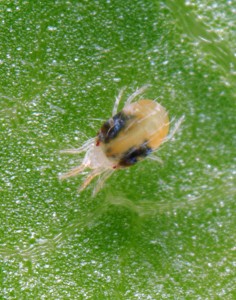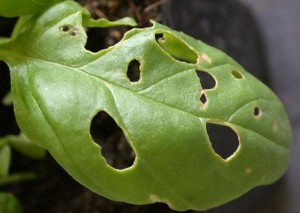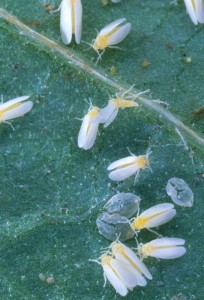How to control garden pests on Salvia divinorum
Salvia divinorum produces soft, lush foliage and is prone to attack by common garden pests such as aphids, caterpillars, snails, white-fly, spider mites, and many others! These bugs can ruin the party so monitor pest populations routinely (once a week). Plants grown under less than ideal conditions are more prone to attack. The best way to prevent pests is to provide the right growing/cultural conditions. Salvia divinorum is otherwise not prone to disease. Fungal leaf spot may be a problem if leaves are kept wet all the time or plants are grown in a cramped space without air circulation.
If you have a pest infestation on your Salvia plant, the remedial action depends on the pest and the density of the population. Very small numbers of pests (low density) are not a problem and require no action. However, their numbers can grow quickly and exponentially. Aphids for instance can multiply so fast that the babies are born pregnant! Monitor pest populations daily, if possible, by checking the undersides of the leaves. Wait and observe. Perhaps benefical wasps or other natural predators will control the pests by themselves. But if their numbers grow past say 7-10 aphids (3-4 Spider mites) on a leaf, it is best to spray. The longer you wait the more work it takes too control.
Here are some tips (all of the pesticides, I recommend are OMRI approved (Organic Materials Research Institute) and are used all the time on organic farms:
1.) Spraying the undersides of the leaves with water (syringing) is a good first step. This will knock bugs off and drown some. Spraying too hard however will damage the leaves.
2.) For aphids, white-fly, and spider mites, an application of Safer-brand insecticidal soap will provide a quick kill on contact. Use the lowest recommended rate, because soap is damaging (phytotoxic) to the leaves of many species of Salvia. Soap essentially dries out the pest, but it can also dehydrate plants with delicate leaves and/or hairs. This damage is made worse by using dish soap that contains even harsher chemicals. Get the Safer brand or Ivory mild dish soap. In any case, Soap should not be used more than 3 times in a 1 month period (due to phytotoxicity). It’s best use is as an initial “knockdown” treatment. Rinse plants off 30 minutes after treatment.
3.) After the soap, wait a few days and apply Neem oil once a week for a month, or until the pests are gone, and then apply preventative treatments every 6-8 weeks. The active ingredient in Neem oil, Azadirachtin, is an insect growth regulator (IGR); it disables pest’s ability to morph into their next growth stage or reproduce. This causes a gradual decline in the population. The insect is supposed to ingest the oil for it to work. But also, the physically oily nature of Neem acts to smother(suffocate) nymphs and spider mites. Neem has anti-fungal properties as well. And, it provides micro-nutrients to the plant as you spray it unlike any other “pesticide” I know. It has a non-objectionable nutty aroma, and is not toxic to people in its natural form (however synthetic, petroleum-based blends, and azadirachtin concentrates are toxic) It should not be applied during hot weather or in direct sun, however (mornings and late afternoon is best.) It also does not burn the leaves unlike soap, pyrethrin, and others.
4.) Salvias, including S. divinorum, are caterpillar candy. Many times they
burrow into the growth tip and causes stem rot. Other symptoms of caterpillar damage are small holes or saw-like incisions chewed in the leaves and no slimy trail (which would indicate slugs or snails). Often times caterpillars are so small you can hardly see them. Look for their poop droppings on the plants. You can use BT (Bacillus thuringiensis) to kill them. BT is a living bacterium that, upon being ingested by the caterpillar, causes it a disease that prevents it from eating and it starves within 3 days. Another one that works very well, and faster is Spinosad (Conserve SC brand). This is a kill on contact pesticide, and does not damage the leaves; it is also effective against thrips and, to a minimal degree, spider mites.
5.) Slugs and snails can be controlled with Sluggo (Iron Phosphate), which comes in a granular form that you sprinkle around the plant. Also, saucers of beer and vinegar left out over night will attract slugs and snails and drown them. They like to hide in moist shady spots during the day, or, in the case of a pot-grown Salvia divinorum plant, look for them inside the container near the drain holes.
6.) Pesticides other than soap, are made better with a “spreader”/ wetting agent, a non-ionic surfactant that breaks the surface tension of the water (prevents water from beading up), allowing for uniform coverage. A good one that I have used is called “Cocowet”, and is naturally derived from the Coconut Tree. There is also “Nu film-P.” Only a few drops per application is needed. When using a spreader/sticker agent, mix it in first with some water and agitate, before the pesticide is added.
Though pesticides are a last resort, they are sometimes necessary to protect your plant. Who wants to ingest the leaves of a Salvia divinorum plant with whitefly egg casings all over it? You can find all of the products listed at a good nursery or hydroponics store. Always follow the label instructions exactly and never spray around bees or where run-off will contaminate ponds or streams; Bee’s, amphibians, and fish are highly sensitive to any toxic chemicals. If you are growing Salvia divinorum in a greenhouse, look into using natural predators, which you can also buy at the hydro store. So after reading this article, I hope you have more understanding on the subject of Salvia divinorum pest control!


